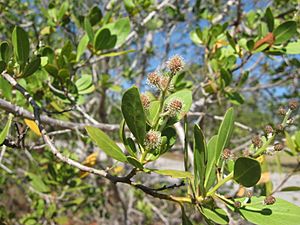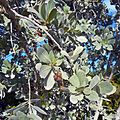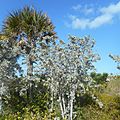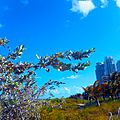Buttonwood facts for kids
Quick facts for kids Buttonwood |
|
|---|---|
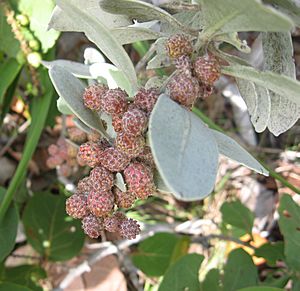 |
|
| Conocarpus erectus var. sericeus in Key Largo, Florida, USA | |
| Conservation status | |
| Scientific classification | |
| Genus: |
Conocarpus
|
| Species: |
erectus
|
The Buttonwood (scientific name: Conocarpus erectus) is a special type of shrub or small tree. It's often called a "button mangrove" because it grows in coastal areas, just like mangroves. You can find it in warm, tropical, and subtropical places all over the world. It belongs to the plant family called Combretaceae.
Contents
Where Buttonwood Grows
Buttonwood plants grow in many warm parts of the world. You can find them in:
- Florida
- Bermuda
- The Bahamas
- The Caribbean islands
- Central America and South America (from Mexico all the way to Brazil on the Atlantic side, and from Mexico to Ecuador on the Pacific side)
- Western Africa
- Islands in Melanesia and Polynesia
It has also been planted in places like Kuwait. This is because it can handle very hot weather and can even use salty water.
What Buttonwood Looks Like
Buttonwood is usually a thick shrub with many trunks. It often grows about 1 to 4 meters (3 to 13 feet) tall. But sometimes, it can grow into a tall tree, reaching over 20 meters (65 feet) high! Its trunk can be as wide as 1 meter (3 feet).
The bark of the buttonwood tree is thick and gray to brown. It has thin scales that peel off in broad pieces. Its branches are easy to break.
Buttonwood Leaves and Flowers
The leaves of the buttonwood grow one after another along the stem. They are simple, oblong, and about 2 to 7 centimeters (1 to 3 inches) long. They are dark green and shiny on top. The underside of the leaves is paler and has fine, silky hairs. At the base of each leaf, there are two special glands that help the plant get rid of salt.
The flowers are very small and don't have petals. They grow in clusters of 35 to 56 flowers.
Buttonwood Fruits
The fruits of the buttonwood look like small buttons, which is how the plant got its name! They are about 5 to 8 millimeters (0.2 to 0.3 inches) wide. The fruit is a cluster of small, scaly, cone-like seeds. These seeds are red to brown and have two small wings.
When the seeds are ready, the seed heads burst open. The seeds are then carried away by water, helping the plant spread to new places.
Buttonwood usually grows in salty water, like in coastal lagoons and bays. But it can also grow inland, sometimes even high up in mountains, like in Costa Rica.
Types of Buttonwood
There are two main types, or varieties, of buttonwood:
- Green Buttonwood (C. e. var. erectus): This type has leaves that are only slightly hairy or have no hairs at all.
- Silver Buttonwood (C. e. var. sericeus): This type has leaves covered in dense, silvery hairs, which makes them look shiny and silver.
How People Use Buttonwood
Buttonwood trees are used in several ways:
For Landscaping and Gardens
Many people plant buttonwood as an ornamental plant in their gardens and yards. The silver buttonwood, with its beautiful silvery leaves, is especially popular for landscaping. It's also used in bonsai, which is the art of growing miniature trees.
This tree is also important for other plants. Many epiphytes, which are plants that grow on other plants (like some orchids), use buttonwood as a host. Because it's planted so much, it has started to grow naturally in places like Hawaii. It's also a very common tree in Kuwait due to its ability to thrive in harsh conditions.
For Wood and Other Products
The wood from buttonwood trees is very strong. It's sometimes used to make cabinets. It can be hard to work with, but it becomes very smooth when finished.
Buttonwood is also used as firewood. It burns very hot and slowly, which makes it good for smoking meat and fish. It also makes high-quality charcoal. The bark of the tree has a lot of tannin, which is a substance used in tanning leather. People used to collect the bark for this purpose.
Gallery
Silver buttonwood growing along sand dunes in Miami Beach (South Beach)
See also
 In Spanish: Conocarpus erectus para niños
In Spanish: Conocarpus erectus para niños



